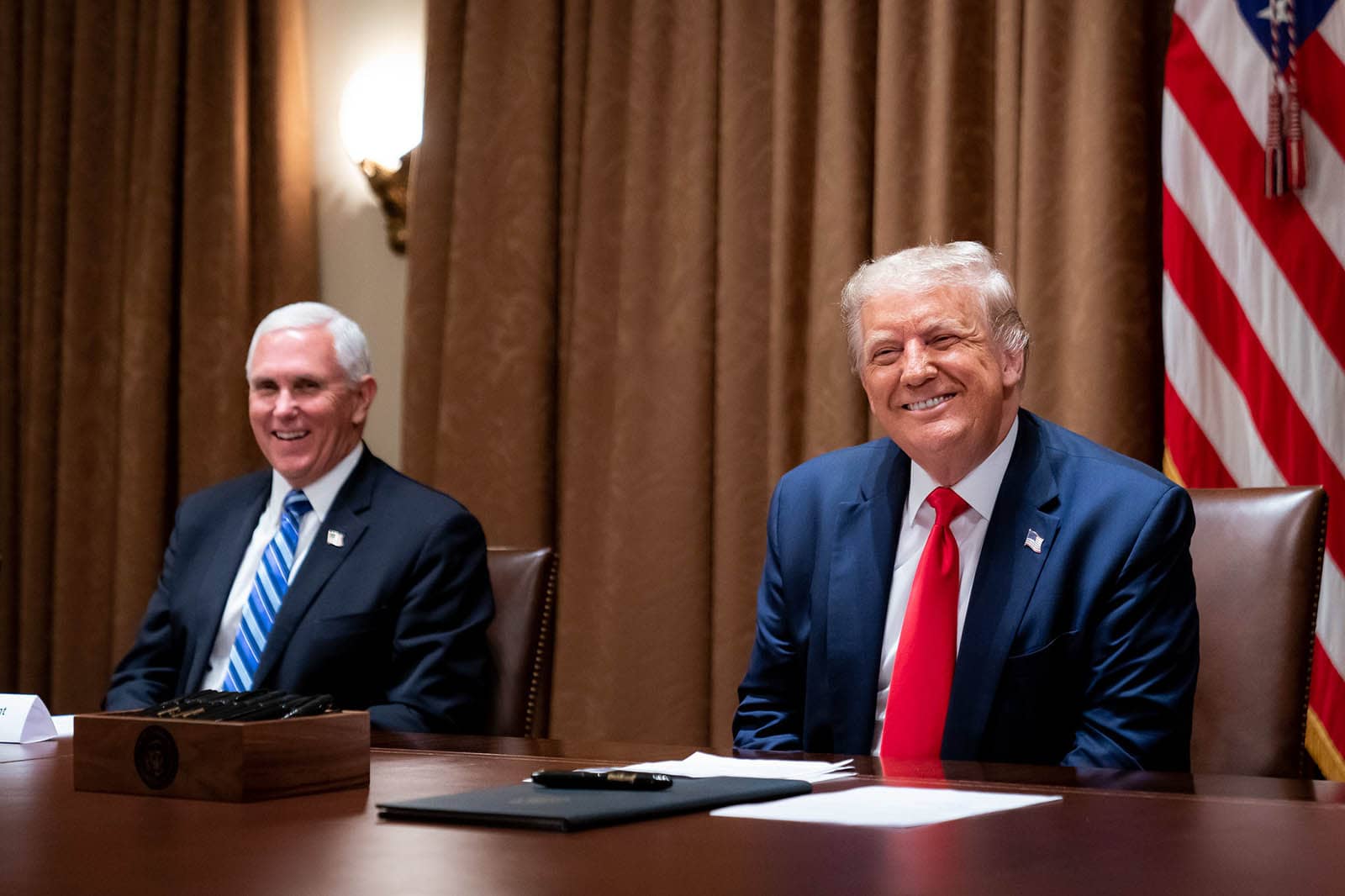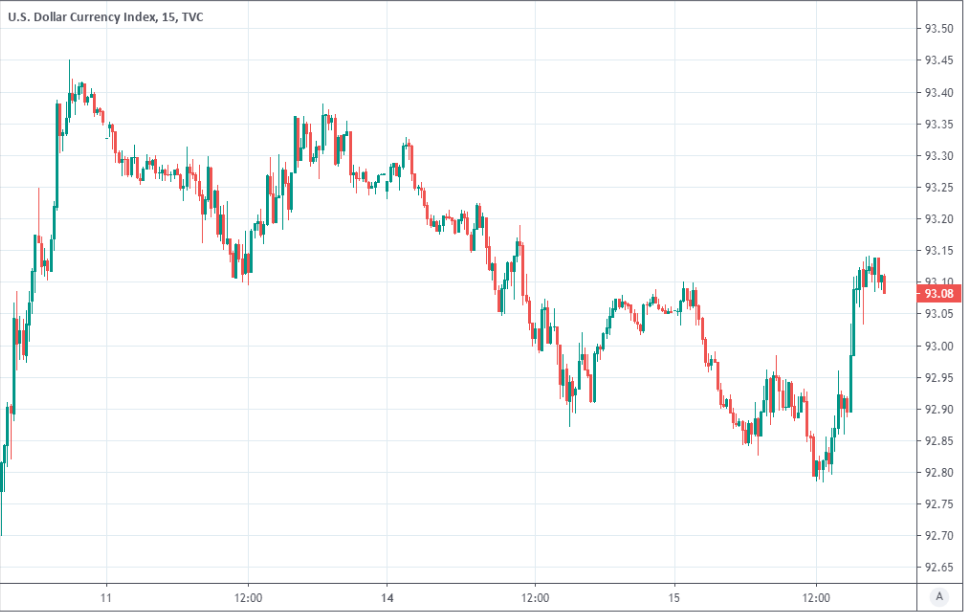Dollar Swings Back into Black, GBP/USD Ebbs as U.S. Poises to Defy WTO on China Trade Tariffs
- Written by: James Skinner
-
-USD rebound aided by EUR/USD retreat, softening of GBP/USD.
-After USTR indicates China trade deal unaffected by WTO ruling.
-WTO says U.S. trade war tariffs unlawful, urges changes by U.S.

Official White House Photo by Tia Dufour
- GBP/USD spot rate at time of writing: 1.2893
- Bank transfer rate (indicative guide): 1.2525-1.2632
- FX specialist providers (indicative guide): 1.2700-1.2777
- More information on FX specialist rates here
The Dollar Index swung back into the black Tuesday after U.S. officials indicated President Donald Trump could ignore a World Trade Organization (WTO) determination that tariffs imposed on China were against its rules and so illegal, undermining the Yuan, EUR/USD and Pound in the process.
U.S. tariffs were imposed on a range of Chinese goods from two separate lists between July 2018 and May 2019 in the most significant escalations of a trade war between the world’s two largest economies. The conflict has roots in the election of President Trump but was largely a 'phony war' until at least March 2018 when the White House imposed levies on steel and aluminium imported from Canada, Mexico the EU, China and others.
The 2018 and 2019 tariffs of 25% on all relevant Chinese goods were the most potent weapon deployed by the U.S., although they had been due to rise to 50% before a ‘phase one deal’ was agreed in November last year and signed this January. Terms of the agreement specify that U.S. tariffs would not increase to 50% but that many existing levies would remain place, which is an outcome that’s been challenged by Tuesday’s WTO determination.
“European traders played catch-up to Asia's “risk-on” tone earlier this morning by bidding up equities and bond yields but EURUSD’s continued struggle with 1.1880s is keeping USDCAD supported once again. Broader risk sentiment has not really taken a hit following this morning's release of weaker than expected US Industrial Production for August,” says Eric Bregar, head of FX strategy at Exchange Bank of Canada, noting how risk appetite had gone undisturbed through much of Tuesday’s European afternoon and North American morning.
Above: Dollar Index shown at 15 minute intervals.
The market mood soured after a WTO dispute settlement panel found as a result of a report published for the first time on Tuesday that the above 25% levies and others “are prima facie inconsistent with Articles...the United States has not met its burden of demonstrating that the measures are provisionally justified under Article XX(a) of the GATT 1994...the Panel concludes that the measures at issue are inconsistent with Articles I:1…..,” before imploring the two parties to reach a solution between themselves.
The WTO panel said the U.S. must now “bring its measures into conformity with its obligations under the GATT 1994,” and that it “expresses its ongoing encouragement to the parties to pursue further efforts to achieve a mutually satisfactory solution,” but U.S. Trade Representative Robert Lighthizer told Fox News the ruling has shown the international body is “completely inadequate to stop china's technology practices.”
Lighthizer's comments could indicate the White House is likely to overlook the findings, which would be another blow for corporate confidence and the international trade environment, although this might also be the limit of the fallout given the system of international trade regulation has been taken offline by a U.S. refusal to appoint a judge to its appellate court. The U.S. also has an opportunity to appeal the decision, which would trigger another process and also stall any implementation of Tuesday’s judgement.
“The US Dollar’s correction higher has been tepid at best. The US Dollar Index has yet to even tackle the 55-day ma let alone the 5-month downtrend at 95.00. While below here the Dollar remains in a long term down move,” says Karen Jones, head of technical analysis for currencies, commodities and bonds at Commerzbank in a Tuesday morning note. “EUR/USD’s 4 month uptrend is holding, and we favour a retest of the 1.2014 recent high.”
Above: Euro-to-Dollar rate shown at daily intervals.
The Dollar had fallen broadly on Tuesday though notably against the Euro and Pound, both collectively accounting for more than two thirds of the ICE barometer of the American currency, although the afternoon’s WTO bombshell appeared to call a halt to the rally in China’s Yuan while pulling a proverbial rug out from under the feet of the Euro-to-Dollar rate.
Europe’s single currency had been lifted overnight by China’s Yuan but was already ebbing before the WTO ruling landed on the wires after failing to derive renewed upward momentum from a sixth consecutive surprise by the ZEW index, though losses picked up in noon trading. ZEW's measure of investor and analysts sentiment toward the Eurozone and German economies rose sharply for a sixth month running but EUR/USD was unable to hold above 1.19.
The Pound-to-Dollar rate was not left untouched although declined to a lesser extent and at a slower pace than the Euro, potentially due to lingering hopes among investors of a climbdown by Prime Minister Boris Johnson over his controversial Internal Market Bill before month-end, or a compromise from one of the sides in discussions aimed at reaching a trade deal. The bill threatens the trade relationship with the EU and could yet prompt more losses for Sterling if investors are left empty handed at the end.
“While Johnson may see opposition at each stage, the bill looks set to eventually pass (some Tory members have proposed an amendment that would force the government to seek approval from the Commons for any changes to the Brexit Withdrawal Agreement). The market’s focus for the GBP is now centred on Thursday’s BoE meeting,” says Shaun Osborne, chief FX strategist at Scotiabank. “Resistance stands at the 23.6% Fib retracement of the recent drop at 1.2933 and the 50-day MA mark of 1.2979. The GBP still has a lot of ground to cover, however, toward its recent high of 1.3482 and we would need to see more convincing price action before we can call a reversal of its losses.”
Above: Pound-to-Dollar rate shown at daily intervals. Finding support ahead of its 200-day moving-average (black line) before subsequent recovery reaches 55-moving average in yellow.













